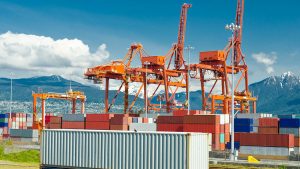While the world economy is still very much in recovery mode, the outlook for this year and next is very robust and well-ahead of long-term trend numbers, Peter Hall, chief economist at Export Development Canada, told attendees at the virtual CanaData conference.
“The world economy is searing hot,” he said. “You can count on that.”
In his presentation entitled The Fork in the Road: Economic Outlook and Strategic Responses, Hall spoke about managing the economy, managing the pandemic and avoiding future lockdowns. The hope was that infection rates would be down by now and economic indicators would be up, he said. Instead, infection rates are up and so is the economy. Going into lockdown again is a great risk.
“We have taken the fork in the road, we are managing the pandemic at the same time as we’re forging ahead with the economy,” Hall said.
Hall also talked about the outlook for the residential, industrial and commercial industries in Canada and the United States.
“The U.S. housing market still very hot,” Hall noted. “This is a market that has not been able to keep up even though the rate of building houses is at its highest point since the global financial crisis by a long shot. We’re seeing U.S. housing starts that are fluctuating on a monthly basis between annualized numbers of 1.5 and 1.7 million. We haven’t seen numbers like that for a long time.
”里面有很多被压抑的需求。S. housing market and I believe that for a number of years we are going to see these high levels of building state side.”
It’s a different story in Canada, he said, which could present challenges for residential builders.
“I’m not hopeful,” Hall stated. “We have a very different market up here than they do there. The fundamental rate of building, its around 185,000 starts and you can see we’ve been well above that for most of the post global financial crisis period here. We dipped down to below 150,000 starts we recovered way faster than the United States and we’ve been building in excess of our needs over that time. What’s going on right now just looks like a monster bubble on the end of a bubble.”
Things are looking up on the industrial side.
“Industrial building has a bright future ahead of it because of the permits we are seeing,” Hall said. “There is almost a rush of activity that is post 2017 and that is signifying that our period of chronic underinvestment since the post global financial crisis period is over. Now we need capacity like crazy at the moment because we are running out of it and I believe that is going to result in new capacity builds here in Canada.”
Other phenomena to watch out for are reshoring, nearshoring and “glocalization.”
“People are worried about their supply chains being far flung around the world,” Hall explained. “You might say that was the case when SARS first hit many years ago and when the Japanese tsunami hit in 2011. That was what people said they were going to do. ‘We’re going to reshore, we’re going to nearshore, we’re going to localize a lot of our supply chains to create redundancies, isn’t this going to be great for industrial building.’ It never happened.”
根据最近的瑞银(UBS)全球的年代tudy, businesses are really serious about it now.
“What we need to get ready for is the proportion of that that is going to come to Canada and arming ourselves for the building that is going to be required as a result of that,” he noted. “All of this is going to need infrastructure. That’s very good news for the construction sector.”
Office buildings are going to have to fill up again before commercial activity picks up.
“I believe that day is not far away,” Hall stated. “I’ve always been a believer that people would be back in big office towers and high vaccination rates are actually leading to that. Firms actually want their people to be in house.”
Going forward, Hall said he believes the growth is going to be in export-focused businesses with an eye on Asia. They are going to need all kinds of capacity, they are going to be expanding their scale multi-fold to keep up with the orders.
“There is a transformation to business that is going on in Canada right now where we are going to be much more focused on Asian growth while we nurture the growth that we have in our other export markets,” he pointed out. “This is going to be a real driver for Canada as we go forward. If we embrace where the growth is going to be, we are going to need lots of capacity to facilitate that.”
Follow the author on Twitter@DCN_Angela.









Recent Comments
comments for this post are closed